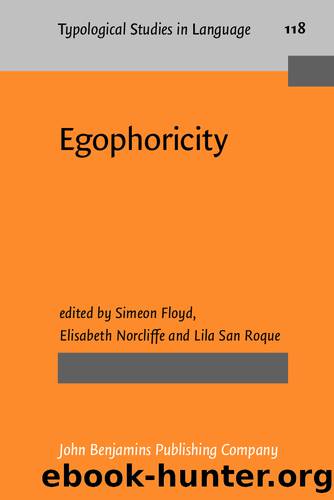Egophoricity by unknow

Author:unknow
Language: eng
Format: epub
Publisher: John Benjamins Publishing Company
Published: 2018-04-13T10:33:20+00:00
There are no i or a vowels here, but the Western Yughur system bears significant semantic similarities to those we have seen in other Amdo Sprachbund languages. Z. Chen describes the basic semantic distinction as one of âcertaintyâ (è¯å® keÌndiÌng), with the two subcategories ç¡®å queÌqieÌ âdefiniteâ (=direct) and æ®é pÇtÅng ânormalâ (=indirect). He tells us (2004:â¯169, my translations) that in the past tense, for example, the âdefiniteâ forms generally appear with the first person in declaratives, and indicate that an event was âeyewitnessed, experienced personally, or absolutely certain.â In contrast, the ânormalâ forms are used in declaratives when âan action was not eyewitnessed or there is no need to emphasize the degree of certainty.â
In contrast to Z. Chen (2004), Roos (2000:â¯100) refers to the more marked Western Yughur forms as âevidentialâ and the less marked forms as âbase forms.â Roos describes the semantic function of the âevidentialâ form as indicating âan action that happens to the speaker without his/her controlling it ⦠or an action that is involuntary.â 19 Despite the difference of perspective, these two authors are clearly describing a form of the direct vs. indirect distinction we have seen in other Amdo Sprachbund languages.
Roos (2000:â¯101) describes an additional finite category, the habitual, which does not seem to allow marking with the âevidentialâ suffix, which has the phonetic shape -É£aq. Thus, like the other languages of the Amdo Sprachbund, Western Yughur seems to have exempted one of its imperfective forms from participation in the direct vs. indirect distinction.
Finally, there is Wutun (Janhunen et al. 2008; Sandman this volume), which has been heavily influenced by Bodic and Mongolic languages. Wutun also has a form of the subjective vs. objective system, which is in many ways reminiscent of the Amdo Tibetan systems described by J. Sun (1993) and Haller (2000), including the borrowing of one of the Tibetan copulas. Sandman (this volume) outlines the details of the system.
Download
This site does not store any files on its server. We only index and link to content provided by other sites. Please contact the content providers to delete copyright contents if any and email us, we'll remove relevant links or contents immediately.
Cecilia; Or, Memoirs of an Heiress — Volume 1 by Fanny Burney(32495)
Cecilia; Or, Memoirs of an Heiress — Volume 2 by Fanny Burney(31909)
Cecilia; Or, Memoirs of an Heiress — Volume 3 by Fanny Burney(31887)
The Lost Art of Listening by Michael P. Nichols(7452)
Asking the Right Questions: A Guide to Critical Thinking by M. Neil Browne & Stuart M. Keeley(5705)
We Need to Talk by Celeste Headlee(5570)
On Writing A Memoir of the Craft by Stephen King(4891)
Dialogue by Robert McKee(4353)
Pre-Suasion: A Revolutionary Way to Influence and Persuade by Robert Cialdini(4182)
I Have Something to Say: Mastering the Art of Public Speaking in an Age of Disconnection by John Bowe(3859)
Elements of Style 2017 by Richard De A'Morelli(3323)
The Book of Human Emotions by Tiffany Watt Smith(3265)
Fluent Forever: How to Learn Any Language Fast and Never Forget It by Gabriel Wyner(3052)
Name Book, The: Over 10,000 Names--Their Meanings, Origins, and Spiritual Significance by Astoria Dorothy(2960)
Good Humor, Bad Taste: A Sociology of the Joke by Kuipers Giselinde(2922)
Why I Write by George Orwell(2911)
The Art Of Deception by Kevin Mitnick(2766)
The Grammaring Guide to English Grammar with Exercises by Péter Simon(2723)
Ancient Worlds by Michael Scott(2648)
